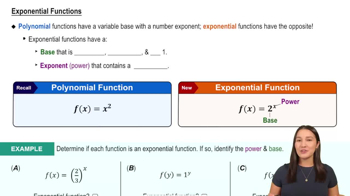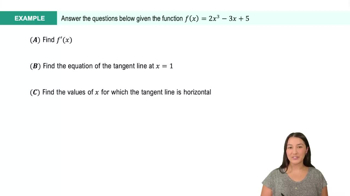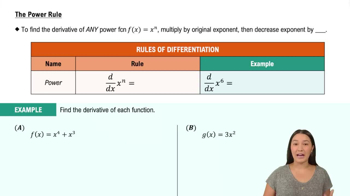Table of contents
- 0. Functions7h 52m
- Introduction to Functions16m
- Piecewise Functions10m
- Properties of Functions9m
- Common Functions1h 8m
- Transformations5m
- Combining Functions27m
- Exponent rules32m
- Exponential Functions28m
- Logarithmic Functions24m
- Properties of Logarithms34m
- Exponential & Logarithmic Equations35m
- Introduction to Trigonometric Functions38m
- Graphs of Trigonometric Functions44m
- Trigonometric Identities47m
- Inverse Trigonometric Functions48m
- 1. Limits and Continuity2h 2m
- 2. Intro to Derivatives1h 33m
- 3. Techniques of Differentiation3h 18m
- 4. Applications of Derivatives2h 38m
- 5. Graphical Applications of Derivatives6h 2m
- 6. Derivatives of Inverse, Exponential, & Logarithmic Functions2h 37m
- 7. Antiderivatives & Indefinite Integrals1h 26m
- 8. Definite Integrals4h 44m
- 9. Graphical Applications of Integrals2h 27m
- 10. Physics Applications of Integrals 2h 22m
3. Techniques of Differentiation
Basic Rules of Differentiation
Problem 82a
Textbook Question
The following limits represent f'(a) for some function f and some real number a.
Find a possible function f and number a.
lim x🠂0 e^x-1 / x
 Verified step by step guidance
Verified step by step guidance1
Step 1: Recognize that the given limit \( \lim_{x \to 0} \frac{e^x - 1}{x} \) is a standard limit that represents the derivative of the exponential function \( f(x) = e^x \) at a specific point.
Step 2: Recall the definition of the derivative \( f'(a) \) for a function \( f(x) \) at a point \( a \), which is given by \( \lim_{x \to a} \frac{f(x) - f(a)}{x - a} \).
Step 3: Compare the given limit with the derivative definition. Notice that the form \( \frac{e^x - 1}{x} \) suggests \( f(x) = e^x \) and \( f(a) = e^0 = 1 \).
Step 4: Identify that the limit \( \lim_{x \to 0} \frac{e^x - 1}{x} \) is equivalent to finding \( f'(0) \) for the function \( f(x) = e^x \).
Step 5: Conclude that a possible function \( f \) is \( f(x) = e^x \) and the number \( a \) is 0, since the derivative \( f'(0) \) is represented by the given limit.
 Verified video answer for a similar problem:
Verified video answer for a similar problem:This video solution was recommended by our tutors as helpful for the problem above
Video duration:
3mPlay a video:
Was this helpful?
Key Concepts
Here are the essential concepts you must grasp in order to answer the question correctly.
Limits
Limits are fundamental in calculus, representing the value that a function approaches as the input approaches a certain point. In this context, the limit as x approaches 0 of (e^x - 1) / x is crucial for determining the derivative of the function at that point. Understanding limits allows us to analyze the behavior of functions near specific values, which is essential for defining derivatives.
Recommended video:

One-Sided Limits
Derivatives
The derivative of a function at a point quantifies the rate at which the function's value changes as its input changes. It is defined as the limit of the average rate of change of the function as the interval approaches zero. In this case, the limit provided represents the derivative of the function f at the point a, which is a key concept in understanding how functions behave locally.
Recommended video:

Derivatives
Exponential Functions
Exponential functions, such as e^x, are functions of the form f(x) = a^x, where 'a' is a constant. The function e^x is particularly important in calculus due to its unique property that its derivative is equal to itself. This property simplifies the process of finding derivatives and limits involving exponential functions, making them a common subject in calculus problems.
Recommended video:

Exponential Functions

 3:59m
3:59mWatch next
Master Derivatives of Linear Functions with a bite sized video explanation from Callie
Start learningRelated Videos
Related Practice







